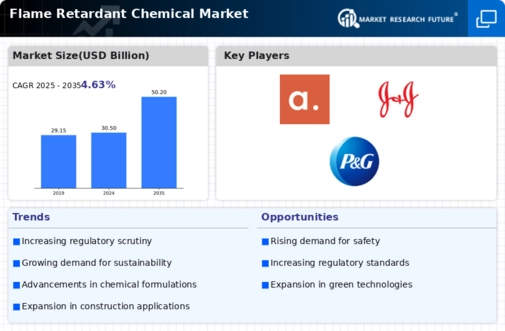Market Growth Chart
Rising Awareness of Fire Safety
Increasing awareness of fire safety among consumers and industries is a significant driver for the Global Flame Retardant Chemical Market Industry. High-profile fire incidents have heightened public consciousness regarding the importance of fire prevention measures. Consequently, industries are prioritizing the incorporation of flame retardants in their products to mitigate fire risks. This trend is particularly evident in sectors such as textiles, where flame retardant treatments are becoming standard practice. As awareness continues to rise, the demand for flame retardants is expected to escalate, contributing to the market's overall growth and stability.
Growing Demand in Construction Sector
The construction sector significantly influences the Global Flame Retardant Chemical Market Industry, as fire safety remains a paramount concern. With the rise in urbanization and infrastructure development, there is an increasing need for flame retardant materials in building products such as insulation, roofing, and wall coverings. The integration of flame retardants in these materials not only enhances safety but also meets regulatory standards. As the construction industry expands, the demand for flame retardants is expected to grow, contributing to the market's projected growth to 50.2 USD Billion by 2035, with a compound annual growth rate of 4.63% from 2025 to 2035.
Regulatory Compliance and Safety Standards
The Global Flame Retardant Chemical Market Industry is increasingly driven by stringent regulatory compliance and safety standards. Governments worldwide are implementing rigorous regulations to enhance fire safety in various sectors, including construction, automotive, and electronics. For instance, the European Union's REACH regulation mandates the registration and evaluation of chemical substances, including flame retardants. This regulatory landscape compels manufacturers to innovate and develop safer, more effective flame retardant solutions. As a result, the market is projected to reach 30.5 USD Billion in 2024, reflecting the industry's adaptation to these evolving safety requirements.
Technological Advancements in Flame Retardants
Technological advancements play a crucial role in shaping the Global Flame Retardant Chemical Market Industry. Innovations in chemical formulations and application techniques are leading to the development of more efficient and environmentally friendly flame retardants. For example, the emergence of non-halogenated flame retardants is gaining traction due to their reduced environmental impact. These advancements not only improve fire safety but also align with global sustainability goals. As manufacturers invest in research and development, the market is likely to witness a surge in demand for advanced flame retardant solutions, further propelling its growth trajectory.
Expansion of Automotive and Electronics Industries
The expansion of the automotive and electronics industries is a pivotal factor influencing the Global Flame Retardant Chemical Market Industry. As vehicles and electronic devices become more complex, the need for flame retardant materials to ensure safety and compliance with regulations is increasing. In the automotive sector, flame retardants are used in interior components, wiring, and insulation to prevent fire hazards. Similarly, in electronics, flame retardants are essential for circuit boards and casings. This growing demand from both sectors is anticipated to drive the market forward, reinforcing its significance in ensuring safety across various applications.


 Source: Primary Research, Secondary Research, MRFR Database and Analyst Review
Source: Primary Research, Secondary Research, MRFR Database and Analyst Review

